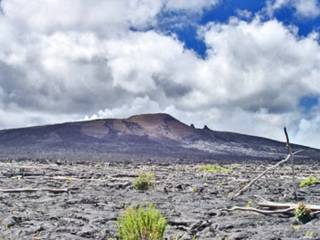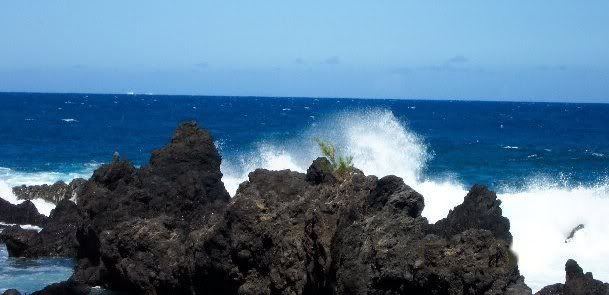December 26, 2004
Volcano Watch Dec 26 2004

Kilauea Volcano Puu Oo vent
With my thanks to the East Hawaii Tribune Herald... They do not put these reports into the archives so I am copying it to my blog for reference to the post for 12-27. Enjoy
All basalts are not born equal ...
Sunday, December 26, 2004 12:00 PM HST
Recently, an important volcanological meeting of minds took place in Pucon, Chile. It was the International Association of Volcanology and Chemistry of the Earth's Interior (IAVCEI) General Assembly, which meets every four years.
Hawaii was well represented at the meeting, with personnel from the USGS's Hawaiian Volcano Observatory, as well as from the University of Hawaii at Hilo and Manoa campuses.
Dr. Andy Harris, researcher at the University of Hawaii at Manoa, scooped the Wager Medal, a top award from IAVCEI, in acknowledgement of his outstanding contributions to the science of volcanology. Dr. Harris is a frequent visitor to the Big Island, where he comes to study lava flow emplacement and conduit dynamics.
The meetings enable people to come together to share their ideas and research on various aspects of volcanology -- magmatic processes, monitoring, volcanic hazards and the environmental impacts of eruptions, among other topics.
The conference took place over five days, four of which were filled with talks and discussion, with one day of field trips to investigate the local volcanoes.
The conference was set in Pucon, in the Lake District of Chile, which lies in the foothills of the Andes.
The Andes Mountains form as the Nazca oceanic plate sinks beneath the South American continental plate.
Andean volcanoes are also the result of subduction.
Due to the amount of seawater in the subducted slab, the magmas in subduction settings are water-rich.
The volcanoes around Pucon are either basaltic, like the Hawaiian volcanoes, or basaltic andesite.
But there is a radical difference in their eruptive style and behavior.
Magmas erupt when dissolved gases bubble out as magma migrates upward through the crust and decompresses.
Sodas do this when you release the bottling pressure by popping the cap, especially after a vigorous shake. Magmas also erupt after they are stored for prolonged periods in a crustal magma chamber and become less dense by cooling, crystallizing and releasing volatiles.
Subduction zone magmas, such as those erupted in the Andean chain, have large amounts of water and less dissolved carbon dioxide.
Primary Hawaiian magma has a large amount of carbon dioxide and little water. Water is much more soluble than carbon dioxide in magma. This difference has a profound effect on the style of the eruptions and how the volcanoes grow.
One consequence of the different magma is the volcano's shape. Subduction zone volcanoes in the Andes, such as Villarica, the volcano nearest to Pucon, typically have a symmetrical, steep-sided morphology and are called stratovolcanoes.
These cones are built up by successive layers of viscous lava flows and ash eruption deposits.
Another consequence is the magma's tendency to explode.
Because water is highly soluble in magma, it remains in the magma longer than carbon dioxide, bubbling out of solution only at a very shallow level (a kilometer (mile) or less) beneath the vent.
The potential for explosive eruption is therefore greater. The magma rushes up the conduit, releasing its water and forming foam, which can explode if the water cannot escape.
In Hawaii, carbon dioxide bubbles out at great depths beneath the volcanoes (this process begins as deep as 50 km (30 miles)), allowing magma to rise through the crust, slowly releasing its carbon dioxide.
By the time it reaches shallow depths beneath the vent, it has largely released all of its volatiles. Explosive eruptions are thus rarer, and effusive lava flows are the dominant style of activity.
As with everything, however, there are exceptions. Lava flows down the flanks of Villarica, and explosive eruptions occasionally rock the Hawaiian volcanoes.
'A'a is the dominant form of lava flows at basaltic volcanoes in subduction zone settings; the lavas are more viscous and more crystalline than Hawaiian lava flows.
The eruptive history of Kilauea includes several episodes of explosive activity, recorded in both oral Hawaiian legends and in the layers of ash fall and pyroclastic surge deposits around Kilauea caldera.
Activity update
Eruptive activity at Pu'u 'O'o continues. Spatter cones in the crater of Pu'u 'O'o glow brightly on clear nights but have not produced any lava flows for several months.
The MLK vent area, at the southwest base of the cone, intermittently erupts small pahoehoe flows that stack up close to the vent.
The PKK flow continues to host scattered breakouts from above the top of Pulama pali to the coastal plain. The on-again, off-again ocean entry at Lae`apuki turned off again December 17. As of December 22, breakouts were active on the coastal plain, about 600 m (656 yd) inland of the shore at Lae'apuki.
The area of breakouts is about 3.2 km (2 mi) from the end of the pavement on Chain of Craters Road in Hawaii Volcanoes National Park. Expect a 2-hour walk each way and remember to bring lots of water. Stay well back from the sea cliff, regardless of whether there is an active ocean entry or not. Heed the National Park warning signs.
During the week ending Dec. 21, several earthquakes were felt on our Big Island. The first had a magnitude of 2.7 and occurred seconds before 2 a.m. on December 20, about 18 km (11 miles) east of Mauna Loa summit, at a depth of 9.7 km (6 miles). It was felt in the Volcano area and as far away as Hilo. Two days later, at least three more earthquakes were distinctly felt in the Volcano area. They happened on December 22 starting at 7:07 a.m. and were all located south of Kilauea summit. The initial shock had a magnitude of 4.0, and the after shocks had magnitudes between 2.0 and 2.4. All were at depths of 3.1-4.2 km (1.9-2.6 miles).
Mauna Loa is not erupting. The summit region continues to inflate. Since July 2004, the rate of inflation and number of deep earthquakes has increased. Weekly earthquake counts have varied from 5 to over 150. During the week ending Dec. 21, over 150 earthquakes were recorded beneath the summit area. This is a distinct increase over the past week. Nearly all are 30 km (18 mi) or more deep and are the long-period type with magnitudes less than 3.
Visit our Web site (hvo.wr.usgs.gov) for daily volcano updates and nearly real-time earthquake information.
This article was written by scientists at the U.S. Geological Survey's Hawaiian Volcano Observatory.
